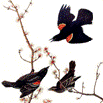Wildlife Damage Management, Internet Center for
Document Type
Article
Date of this Version
September 1966
Abstract
A chemosterilant may be defined as a chemical compound that reduces or destroys fertility of the treated animal. There are a variety of compounds which have an anti-fertility effect, and these com¬pounds may attack the reproductive process at any one of its many phases. Chemosterilants have a good potential as a means of population control of pest animals, because the population may be reduced with little reproductive compensation which normally follows a reduction caused by killing. The number of young produced would be reduced by preventing reproduction or by causing early mortality; therefore, there would be little compensatory increase in reproduction following treatment. Treated animals would remain in competition with productive animals and prevent immigration into and replacement in the population by fertile animals (previously non-productive young). Also there would be little increase in survival rate of the young because competition from the adult population would not be changed. The use of chemosterilants is a practical method of control because it involves inexpensive materials, is easily applied, and can not be detected by the target animals. Extensive research on chemosterilants has been and is being con¬ducted on a number of species of insects. Populations of several species have been successfully controlled with the chemosterilant apholate (Chamberlain, 1962; Harris, 1962). The amount of research on the use of chemosterilants on birds has been meager. Davis (1962) conducted laboratory tests on starlings and found that as little as 0.1 rag of T.E.M. (triethylenemelamine) for 3 days would inhibit the growth of testes and ovaries. He also found that 0.1 mg per day for 3 weeks caused sexually mature testes to regress. A field experiment on red-winged blackbirds using treated cracked corn showed that T.E.M. caused a 20 to 45 per cent reduction in the number of nestlings (fewer nests and lower hatchability of eggs) in the treated populations (Vandenbergh and Davis, 1962). The size of testes of treated birds was reduced and there was no discernible effect on behavior. Sudan Black B dye had an embryocidal effect on eggs produced by gulls fed treated bait (Wetherbee, et al., 1964). The anti-fertility effect of a number of compounds was tested on pigeons by Elder (1964). He found that T.E.M. was not effective, but he did find that an anticholesterol agent (SC-12937) inhibited ovulation for up to 3 months. I selected apholate (an alkylating agent) to test control of repro¬duction in pigeons and evaluate the effects of reduced birth rate on population growth; however, effectiveness of the chemosterilant had to be assessed first. The acceptability of treated bait was investigated with 18 pigeons which were tested individually for nine different treatments of corn. The pigeons readily accepted treated bait at concentrations up to 1.0 per cent when presented with individual pieces of corn, but 0.3 per cent apholate was the highest concentration pigeons would accept in their daily food (60 mg per bird dosage). Next, the range of dosages that had an anti-fertility effect was determined. Five groups of pairs of pigeons, kept in indoor cages under constant laboratory conditions, were given different dosages (Table 1) in a one-day exposure (except 2 days for the group receiving the 101 mg dosage). Egg production was delayed and hatchability of eggs reduced in the groups receiving 20 mg to 101 mg of apholate per bird (Table 1). Also, the effect of the compound on the social behavior of pigeons was evaluated since an ideal chemosterilant should not change competitive behavior of sterilized birds. The behavior (24 types of sexual and agonistic behavior) of the same 5 groups of pigeons (Table 1) was observed for 10 minutes per group per day. Behavior was not seriously altered by the chemosterilant. Only at 101 mg per bird was there any observable ef¬fect on the level of behavior, whereas the frequency of behavior was not affected. Two types of sexual behavior were significantly less fol¬lowing treatment in the 101 mg group, but the reduction was a result of temporary toxic effects of apholate. The birds were inactive for the first week following treatment, but they gradually recovered after 2 weeks to the pre-treatment levels. Birds maintained their nest sites while they were infertile.


